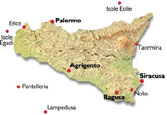|
Probably my favourite Sicilian city - perhaps because I know it best, having visited it more t han the others (most recently for a week in May 2007), perhaps because it's the most Greek. The modern city is still divided up into the five ancient districts: Ortigia, Acradina, Tyche, Neapoli and Epipoli.
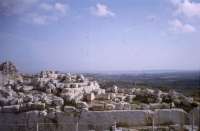 By road, my preferred approach is from the north-west, via Belvedere, stopping at the fortifications of Eurialo (Euryalus on the heights of Epipoli - ancient Epipolae). Not only is Dionysius' military architecture extremely impressive (largely due to the involvement of Archimedes, one imagines), and definitely worth a visit for its own sake, but the view over Syracuse is an excellent preparation for the visit. The two harbours guarding the island of Ortygia - the oldest part of the city - can be seen clearly, but the most striking feature is how much empty space there is between where you stand and the modern city. In ancient times the city began right below you and filled the entire foreground, as well as stretching away to the north, where there is also plenty of space today. This is important, because once you get down into it, Syracuse seems a large bustling city: remember that's it's a shadow of its former self. (As is Agrigento - while the city of Selinus - Selinunte - once the largest of them all is completely deserted). The only building you can make out is probably the massive modern church of Madonna delle Lácrime, whose electronic bell chimes will irritate you throughout your visit. By road, my preferred approach is from the north-west, via Belvedere, stopping at the fortifications of Eurialo (Euryalus on the heights of Epipoli - ancient Epipolae). Not only is Dionysius' military architecture extremely impressive (largely due to the involvement of Archimedes, one imagines), and definitely worth a visit for its own sake, but the view over Syracuse is an excellent preparation for the visit. The two harbours guarding the island of Ortygia - the oldest part of the city - can be seen clearly, but the most striking feature is how much empty space there is between where you stand and the modern city. In ancient times the city began right below you and filled the entire foreground, as well as stretching away to the north, where there is also plenty of space today. This is important, because once you get down into it, Syracuse seems a large bustling city: remember that's it's a shadow of its former self. (As is Agrigento - while the city of Selinus - Selinunte - once the largest of them all is completely deserted). The only building you can make out is probably the massive modern church of Madonna delle Lácrime, whose electronic bell chimes will irritate you throughout your visit.
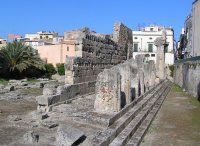 Ortigia (Ancient Ortygia: Quail island - also a name for Apollo's holy isle of Delos): The heart of the ancient Greek city (founded from Corinth in about 734 BC). The oldest building is the Temple of Apollo, which you pass as you make your way towards the main hub of Ortygia, the Piazza Archimede, named for Syracuse's most distinguished citizen. This temple is probably the oldest surviving one anywhere (around 600BC) planned to have stone columns (in older ones, stone would have replaced the original wood: notice how those here are squat and very close together). There's an inscription on the top step of the east podium recording the proud generosity of Kleomenes, who was probably responsible for these splendid columns. Ortigia (Ancient Ortygia: Quail island - also a name for Apollo's holy isle of Delos): The heart of the ancient Greek city (founded from Corinth in about 734 BC). The oldest building is the Temple of Apollo, which you pass as you make your way towards the main hub of Ortygia, the Piazza Archimede, named for Syracuse's most distinguished citizen. This temple is probably the oldest surviving one anywhere (around 600BC) planned to have stone columns (in older ones, stone would have replaced the original wood: notice how those here are squat and very close together). There's an inscription on the top step of the east podium recording the proud generosity of Kleomenes, who was probably responsible for these splendid columns.
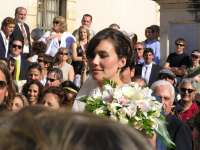 From the Piazza Archimede (with its fountain showing Arethusa's metamorphosis into a spring - see below) narrow streets take you to the Piazza del Duomo, where you will be tempted to sit, order a drink and watch the passeggiata of tourists and locals. Almost certainly, if you are at a weekend, there will be a wedding: if you are lucky there'll be a brass band to accompany the happy pair as they pose on the cathedral steps. There'll also be an opportunity to appraise the guests - the women are all unfeasibly beautiful, and the men immaculate (the fashion when I was there in May 2005 was superbly cut dark suits worn with bizarre and exotic trainers). When the crowd clears you may actually be able to enter the duomo - and, if you had not done your reading, be amazed to discover that you are inside a Greek temple. From the Piazza Archimede (with its fountain showing Arethusa's metamorphosis into a spring - see below) narrow streets take you to the Piazza del Duomo, where you will be tempted to sit, order a drink and watch the passeggiata of tourists and locals. Almost certainly, if you are at a weekend, there will be a wedding: if you are lucky there'll be a brass band to accompany the happy pair as they pose on the cathedral steps. There'll also be an opportunity to appraise the guests - the women are all unfeasibly beautiful, and the men immaculate (the fashion when I was there in May 2005 was superbly cut dark suits worn with bizarre and exotic trainers). When the crowd clears you may actually be able to enter the duomo - and, if you had not done your reading, be amazed to discover that you are inside a Greek temple.
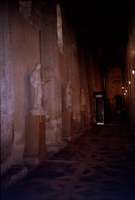 The ancient Temple of Athena (traditional Doric, built by the tyrant Gelon to celebrate the Greek victory over the Carthaginians in 480 BC - the same year that their mainland compatriots were defeating the Persians at Salamis) was made into a Christian church in 640 AD. After the 1693 earthquake - which wreaked such havoc in south eastern Sicily - the present baroque facade replaced the collapsed Norman one. The interior was remodelled in the 1920, when the great Doric columns in the interior were exposed. Next to Gelon's temple, and in complete contrast to it once stood a temple to Athena in the Ionic order - begun about 530 BC, and the only such temple outside Asia Minor. There are no visible remains, and the reason for the choice of the Ionic order is unknown. There are wonderful models of this temple, and Gelon's temple in the Museo Paolo Orsi (the Archaeological Museum). The ancient Temple of Athena (traditional Doric, built by the tyrant Gelon to celebrate the Greek victory over the Carthaginians in 480 BC - the same year that their mainland compatriots were defeating the Persians at Salamis) was made into a Christian church in 640 AD. After the 1693 earthquake - which wreaked such havoc in south eastern Sicily - the present baroque facade replaced the collapsed Norman one. The interior was remodelled in the 1920, when the great Doric columns in the interior were exposed. Next to Gelon's temple, and in complete contrast to it once stood a temple to Athena in the Ionic order - begun about 530 BC, and the only such temple outside Asia Minor. There are no visible remains, and the reason for the choice of the Ionic order is unknown. There are wonderful models of this temple, and Gelon's temple in the Museo Paolo Orsi (the Archaeological Museum).
Another unmissable thing in Ortygia is the Palazzo Bellomo (although it may be unavoidable to miss it, as it's been closed for restoration for some time), but it no longer contains Caravaggio's Burial of St Lucy, which some say was his masterpiece; it is now (May 2007) back in the original setting for which it was painted in the church of Santa Lucia. Another way of seeing the Caravaggio is the visit this amazing site: The Impossible Exhibition - The Complete Works of Caravaggio.
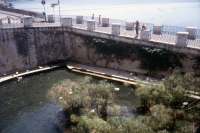 Difficult to avoid is the litter-filled, duck-infested tourist trap which is the Fontana di Aretusa. This miraculous spring of fresh water just a few yards from the sea was known to the ancients, who devised the myth: the nymph Arethusa, hot after hunting, jumped into the river Alpheus (near Olympia, site of the original games) to cool off. The river god fell in love, and chased her all over the local countryside. Exhausted, she begged for help from Artemis, who promptly - and somewhat unhelpfully one might imagine - turned her into a spring. This enabled Alpheus to mingle his water with hers - but Artemis - perhaps trying to make amends, opened an underground (and undersea) passage, which allowed her to escape. Her water disappeared, and came up again in Ortygia. But Alpheus had not given up; he followed her and they mingled their waters again. The "truth" of this tale was allegedly proven by the waters of the Fountain of Arethusa turning red after sacrifices at Olympia - and anything lost in the Alpheus eventually would turn up in Syracuse. But the spring was undoubtedly still fresh in the early 19th century, when Nelson took on water from it on his way to the Battle of the Nile. If you follow the shore line of the Great Harbour, you will pass the Castello Maniace - a fortification built by Frederick II in the 13th century, and still a military barracks. Once past it, you are in a warren of quiet dilapidated streets - quite surprising after the busy tourist quarter you've just left. Egyptian papyrus grows there, uniquely in Europe, and along the River Ciane across the harbour. Difficult to avoid is the litter-filled, duck-infested tourist trap which is the Fontana di Aretusa. This miraculous spring of fresh water just a few yards from the sea was known to the ancients, who devised the myth: the nymph Arethusa, hot after hunting, jumped into the river Alpheus (near Olympia, site of the original games) to cool off. The river god fell in love, and chased her all over the local countryside. Exhausted, she begged for help from Artemis, who promptly - and somewhat unhelpfully one might imagine - turned her into a spring. This enabled Alpheus to mingle his water with hers - but Artemis - perhaps trying to make amends, opened an underground (and undersea) passage, which allowed her to escape. Her water disappeared, and came up again in Ortygia. But Alpheus had not given up; he followed her and they mingled their waters again. The "truth" of this tale was allegedly proven by the waters of the Fountain of Arethusa turning red after sacrifices at Olympia - and anything lost in the Alpheus eventually would turn up in Syracuse. But the spring was undoubtedly still fresh in the early 19th century, when Nelson took on water from it on his way to the Battle of the Nile. If you follow the shore line of the Great Harbour, you will pass the Castello Maniace - a fortification built by Frederick II in the 13th century, and still a military barracks. Once past it, you are in a warren of quiet dilapidated streets - quite surprising after the busy tourist quarter you've just left. Egyptian papyrus grows there, uniquely in Europe, and along the River Ciane across the harbour.
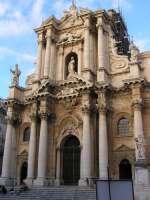 Acradina (ancient Achradina) is where the ancient city first overflowed on to the mainland, but thanks to allied and German bombing there's little to suggest the once beautiful suburb, whose capture by the Romans made Plutarch cry. You can see the site of the ancient Agora (in a sad little park called the Foro Siracusano), and it's worth trying to find the little Roman theatre, called, strangely, the Ginnasio Romano. It enabled theatre to continue when the Romans had commandeered the main one for use as an arena. Acradina (ancient Achradina) is where the ancient city first overflowed on to the mainland, but thanks to allied and German bombing there's little to suggest the once beautiful suburb, whose capture by the Romans made Plutarch cry. You can see the site of the ancient Agora (in a sad little park called the Foro Siracusano), and it's worth trying to find the little Roman theatre, called, strangely, the Ginnasio Romano. It enabled theatre to continue when the Romans had commandeered the main one for use as an arena.
Tyche, to the east of Achradina contains recent excavations of houses and streets from the Greek and Roman periods - not yet open to the public. The most conspicuous building (audibly and visibly) is the aforementioned church of the Madonna delle Lácrime, housing a statue which apparently wept for five days back in 1953. There are also very extensive catacombs, dating from the early Christian period - mostly inaccessible except for those under the ruined church of San Giovanni. But the jewel of this part of town is the Museo Archeológico Paolo Orsi, a superb modern museum housing finds from Syracuse and other Sicilian centres, starting with prehistoric finds from Pantálica. Star exhibits include the Landolina Venus, several fine kouroi, and, best of all, the Kourotrophos from Megara Hyblaea. In the Piazza Santa Lucia is to be found the Chiesa di Santa Lucia whose altarpiece is Caravaggio's masterpiece, The Burial of St Lucy.
Neapoli (Ancient Neapolis - New City). This was the ancient centre for religious activities, and has always been uninhabited. Today the important things to see are the Greek Theatre - seating 15,000 after its extension by Hiero II in 3rd century BC - and adapted by the Romans for gladiatorial shows. There's an annual Greek Drama Festival in May - which I attended again this year. In 2005, I saw Aeschylus' Seven Against Thebes, and Sophocles' Antigone, and this year (2007) Sophocles' Trachiniae and Euripides' Heracles.
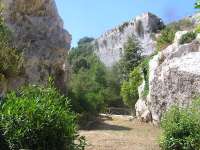 Also to be seen is Hiero's Altar - 200 feet long, where 450 bulls were slaughtered annually, according to Diodorus Siculus. Other ghoulish sites in Neapolis include the Quarries where 7000 Athenian prisoners were penned after the failure of the Sicilian Expedition and their defeat by Syracusan forces in 413 BC, and the Roman Amphitheatre - the largest extant. A tank in the centre was probably used to drain the blood of the victims of slaughter, and was popular with the local invalids, who believed that the warm blood could cure their ailments. Also to be seen is Hiero's Altar - 200 feet long, where 450 bulls were slaughtered annually, according to Diodorus Siculus. Other ghoulish sites in Neapolis include the Quarries where 7000 Athenian prisoners were penned after the failure of the Sicilian Expedition and their defeat by Syracusan forces in 413 BC, and the Roman Amphitheatre - the largest extant. A tank in the centre was probably used to drain the blood of the victims of slaughter, and was popular with the local invalids, who believed that the warm blood could cure their ailments.
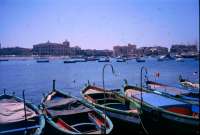
The Small Harbour at Siracusa
|

